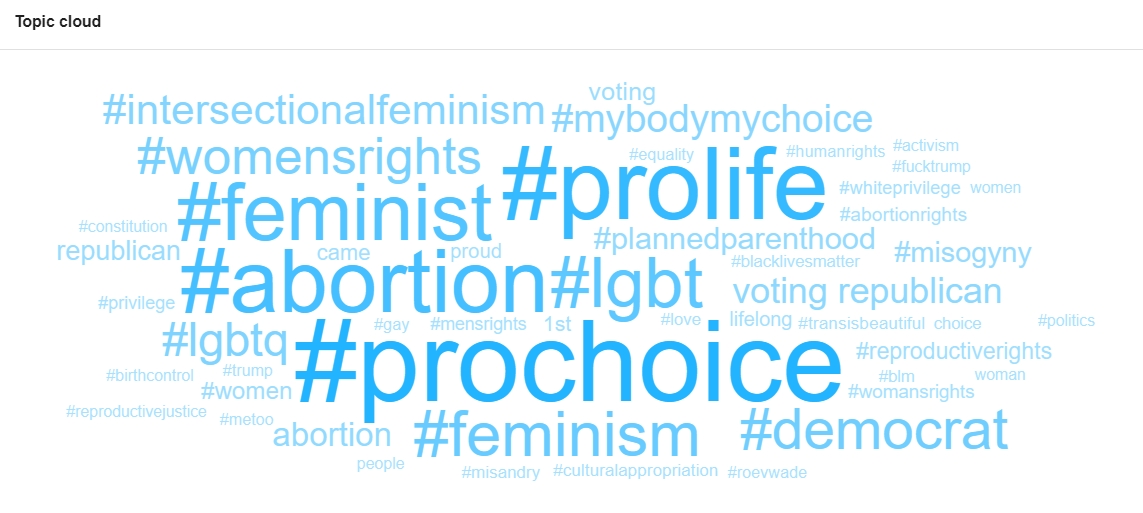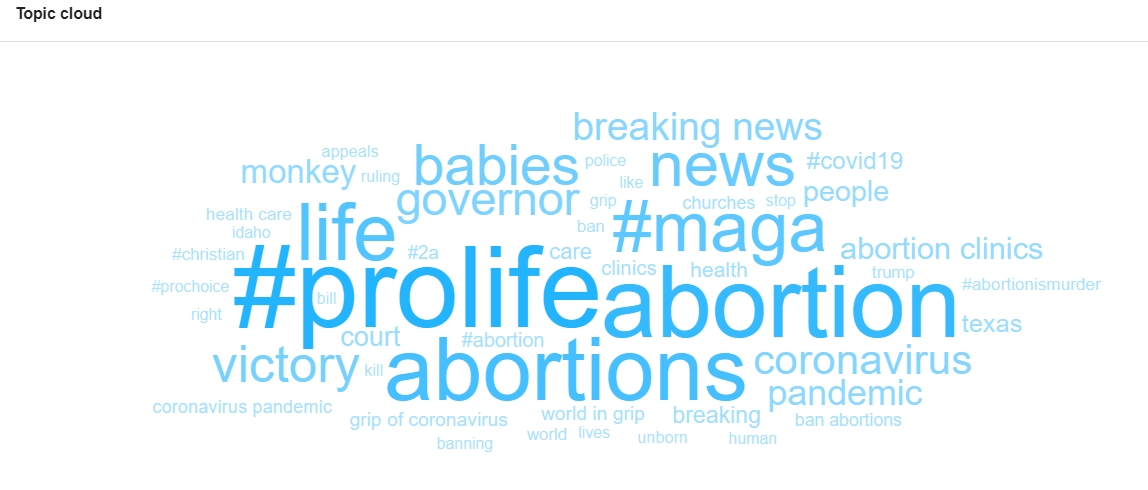Hashtag listening study: #prochoice vs #prolife by state

Social media is a unique platform for studying public discourse around controversial topics. Firstly, it’s where freedom of speech blossoms. Secondly, social media has hashtags.
Yes, if you’re studying attitudes, hashtags skew the data. Some hashtags become more popular than others due to being simpler and smarter, not because the public support is bigger for a particular cause. For example, #MAGA was obviously a better hashtag than #StrongerTogether. #MAGA is a call to action, it’s much shorter, it’s individualistic as opposed to collectivistic (hello, American values). Its use became organic and created a much bigger buzz online, which was not necessarily reflective of the 2016 election results (we know more people voted Hillary).
Hashtags are exciting to study not so much to assess the public’s prevailing opinion on something but to assess the “marketing” part of both sides of the debate. Hashtags’ popularity is important by itself - the more people use a hashtag, the more people will see the cause, and consider supporting this cause.
So, this is a hashtag analysis. I don’t claim the results of the analysis reflect the public’s opinion on abortion rights. I am also aware that the dichotomy behind opposing hashtags is ridiculous: we live in a weird world in which somehow you can’t be both pro life and pro choice, as Stephen Fry pointed out. I’ll merely show you which states use more #prolife hashtags and which use more #prochoice hashtags, and hope you’ll find this interesting. Later, I’ll compare the social listening results to survey results on abortion rights made by Pew Research Center and dive into some other, equally exciting studies and discussions.
In addition to all this, we know that sometimes it’s a breakdown by state that’s actually important, not the total number of people who are on one or the other side of the debate (hello, President Trump, the 45th President of the United States). Hence,
#prolife vs #prochoice hashtags analysis by state
Using our social listening tool Awario, I monitored the usage of “#prolife” and “#prochoice” on Twitter and Facebook from mid-February to mid-April, 2020.
There was a limit of one mention per author so that the results would not get distorted because of multiple tweets by a single person.
Here I present the color-coded maps with the hashtag listening results.
The total number of unique authors mentioning abortion-related hashtags
Zoom out or zoom in to see all the states and hover over a state to see its results.
Unsurprisingly, the states with the biggest populations - Texas and California - have the biggest number of abortion-related mentions. But also, Texas, which has fewer people than California, brought 30% more mentions. How did this happen?
Digging into mentions uncovered the conversations that brought so much attention from Texas residents.
How "pro life" of them>> Texas lawmakers consider the death penalty for abortion #ProLifeMyAss https://t.co/M8Q7SUIxfG
— Laffy (@GottaLaff) April 10, 2019
Nothing similarly scandalous and attention-grabbing is happening in California or the third most populated state - New York.
However, to get a more objective picture of the scope of the conversation, we made a different map.
Unique authors using abortion-related hashtags per 100K population
Zoom out or zoom in to see all the states and hover over a state to see its results.
Top states that are most vocal about the abortion debate:
- District of Columbia
- Wyoming
While nothing exceptional is happening in DC - people seem to be just generally more concerned about abortions there - Wyoming stands out for a reason. The Mentions feed revealed that it’s the recent viral news that sparked the debate. Wyoming governor allegedly vetoed the medical care bill that aimed at babies who survived the abortion.
Wyoming Gov Vetoes Bill for Medical Care for Babies Who Survive Abortions: Let Them Just “Pass Away”!
— LAYLA ⭐️⭐️⭐️ (@LaylaAlisha11) March 28, 2020
Mark Gordon is Supposed to be a Pro-Life Governor & he can’t even sign legislation that gives Babies who survive botched Abortions medical care?!
AWFUL!https://t.co/ErrjcQG5Hz
#prolife vs #prochoice hashtags by US state
First, it’s clear that a pro-life hashtag is generally much more popular than a pro-choice hashtag. Second, you can finally see the distribution by state. Zoom out to see all the states and hover over a state to see its results.
Top 5 #prochoice states:
- New Mexico
- New Hampshire
- Minnesota
- Alaska
- California
Top 5 #prolife states:
- Missouri
- Alabama
- North Carolina
- Louisiana
- Oklahoma
Topics that pop up most often when people use #prochoice and #prolife hashtags
Here's a Topic Cloud for #prochoice:

and here's a Topic Cloud for #prolife:

Discussion
So, despite what we’ve discussed in the introduction, we have to answer the burning question:
Does the overwhelming use of pro-life hashtag mean the majority of Americans is anti-abortion?
The answer is no.
The recent poll (2019) shows that the US population is as divided on this topic as on all other major social issues. 43% of women identify themselves as pro-choice and 51% identify themselves as pro-life. 6% are undecided. Among men, 48% consider themselves pro-choice and 46% - pro-life. 6% are once again undecided. Demographics and SES play important roles in people’s attitudes to abortions; as do, of course, political views. Younger, more educated, richer, liberal, democratic, and non-religious people are more likely to be pro-choice, leaving the opposites to be more pro-life.
And what about the attitude by state?
A 2014 poll on abortion attitude by state showed the following results:

Surely, you can see some similarities with the hashtag map. All states that believe that abortion should be illegal are red or blood orange on our map - except for West Virginia. Colorado, which stands out in the poll as the only one for legal abortions among the undecided (divided) states, also stands out on the hashtag map as the one that uses less pro-life hashtags. California, Alaska, New Hampshire, Maryland are all for legal abortions and less into pro-life hashtags. However, I am sure you also see enough differences between the maps. Also, it’s hard to forget that even “green” states have more pro-life hashtags than pro-choice hashtags. Maybe, our data is wrong?
Most likely, it’s not. A study that analyzed the abortion debate on social media in 2017 showed somewhat similar results. They found that the “for abortion” message is expressed in 19.8% of the tweets, while the “against abortion” message occurs in 60.6% of the tweets.
So how come the hashtag usage doesn’t correlate with the people’s views?
The first reason is clear as day - pro-life supporters are more active on social media because they are much more motivated to be active - abortion is legal in all US states.
The second reason is a bit more complicated. Remember how we talked about hashtag use being a lot about marketing? Seems like pro-life activists are simply better at social media marketing. The situation is best described by a pro-choice journalist from Dame magazine who wrote an article “The anti-abortion movement is killing it on Twitter”. She gives examples of successful Twitter activities executed by pro-lifers and goes on to interview the pro-life SMM pros themselves to find out more about the methods.
She discovers that the pro-life movement organizers employ the following tactics:
1. Using trending topics to piggyback on. For example, if there’s a neutral trending hashtag like #beststoryin5words, pro-life activists use it to distribute anti-abortion messages.
This is done to constantly remind people that abortion exists. Pro-life activists point out that people don’t like to think about abortions, ever, and it’s necessary to remind them that that’s happening and to stir up conversations.
2. Hijacking pro-choice hashtags and live tweet events to distribute pro-life messages.
For example, when there are educational events from abortion providers. While the tactic is generally not common among SMM specialists, it’s definitely effective for distributing pro-life hashtags.
3. Building a well-organized communication strategy.
Pro-life activists point out that when it comes to social media marketing, plenty of organizations, as well as stay-at-home mothers and grandmothers, work as one. Information travels quickly, and activists turn to Twitter to do their part.
What are the implications of this study?
Here are the ones that come to my (forcefully) unbiased mind.
-
For both pro-life and pro-choice activists, it makes sense to focus their efforts on “undecided” states that are flooded with #prolife messages.
-
Pro-choice activists might want to put more effort into social media marketing, work to become less fractionalized, and improve communication between themselves.
-
Conservative politicians could change the intensity of their pro-life stand depending on which states are important to them and focus on states that have active pro-life groups spreading the message.
By signing up I agree to the Terms of Use and Privacy Policy
Do you have any other ideas, comments, or questions? Please share in the comment section below.













